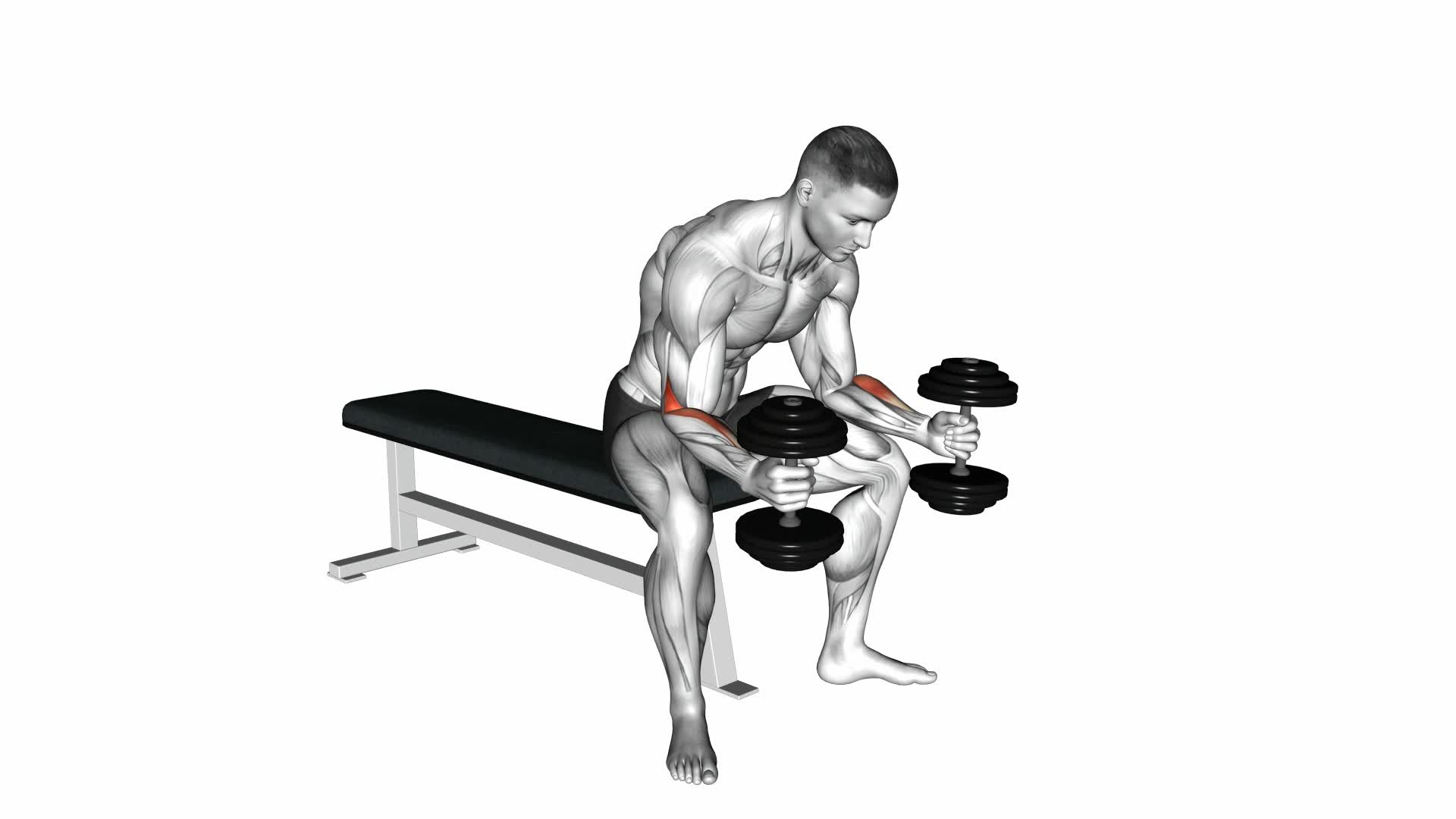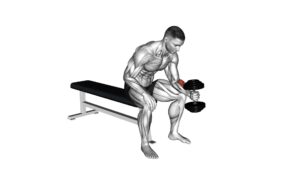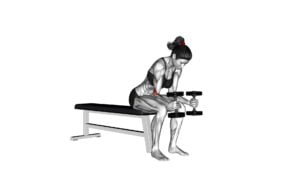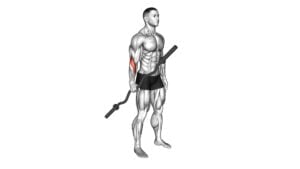Dumbbell Seated Neutral Wrist Curl – Video Exercise Guide & Tips

Looking to strengthen your wrists? Try the dumbbell seated neutral wrist curl! This exercise targets the muscles in your forearms and can help improve grip strength.
Watch This Exercise Video
In this video exercise guide, you'll learn the proper form and technique for performing this exercise, as well as variations and modifications to challenge yourself.
Maximize your results by following our tips and avoiding common mistakes. Get ready to feel the burn and see the gains with the dumbbell seated neutral wrist curl!
Key Takeaways
- The Dumbbell Seated Neutral Wrist Curl targets muscles in the forearms and wrists, improving grip strength and wrist stability.
- Proper form and technique, including maintaining a neutral wrist position and using controlled movements, are crucial for maximizing the benefits of this exercise.
- Avoid common mistakes such as improper wrist positioning, using excessive weight, rushing through the exercise, and neglecting to engage the forearms and wrists.
- Variations and modifications, such as the reverse wrist curl and seated pronated wrist curl, can be used to gradually increase intensity and progress as strength improves.
Benefits of the Dumbbell Seated Neutral Wrist Curl
You can experience increased forearm strength and improved wrist stability by incorporating the dumbbell seated neutral wrist curl into your workout routine. This exercise specifically targets the muscles in your forearms and wrists, helping to improve your grip strength and overall wrist stability.
By performing the dumbbell seated neutral wrist curl, you can strengthen the muscles responsible for flexing and extending your wrists, which are essential for various daily activities and sports.
The seated position ensures proper form and stability throughout the exercise, allowing you to focus solely on engaging your forearms and wrists. To perform the exercise, sit on a bench or chair with your feet flat on the floor. Hold a dumbbell in each hand, palms facing up, and rest your forearms on your thighs.
Begin by slowly raising the dumbbells towards your body, curling your wrists upwards while keeping your forearms stationary. Pause for a moment at the top, then slowly lower the dumbbells back to the starting position. Repeat for the desired number of repetitions.
Incorporating the dumbbell seated neutral wrist curl into your workout routine can help improve your grip strength and enhance wrist stability, allowing you to perform everyday tasks with ease and excel in sports that require strong forearms and wrists.
Proper Form and Technique for the Dumbbell Seated Neutral Wrist Curl
To perform the dumbbell seated neutral wrist curl with proper form and technique, focus on engaging your forearms and wrists while keeping your palms facing up and your forearms stationary. Here are three key tips to help you execute this exercise correctly:
- Sit on a flat bench with your feet flat on the floor and hold a dumbbell in each hand, palms facing up. Rest your forearms on your thighs, allowing your wrists to hang off the edge.
- Slowly curl your wrists upward, bringing the dumbbells towards your body. Focus on squeezing your forearms and wrists as you lift the weight. Keep your forearms stationary throughout the movement.
- Once you reach the top of the curl, hold the position for a brief moment, then slowly lower the dumbbells back down to the starting position, allowing your wrists to fully extend.
By following these steps, you can maximize the benefits of the dumbbell seated neutral wrist curl.
However, it's important to be aware of some common mistakes to avoid. One common error is using too much weight, which can lead to improper form and strain on your wrists. Start with lighter weights and gradually increase as you gain strength and confidence.
Another mistake is relying on momentum to lift the weights, rather than using controlled movements. Remember to engage your forearms and wrists throughout the exercise for optimal results.
Variations and Modifications for the Dumbbell Seated Neutral Wrist Curl
To add variety to your wrist curl routine, consider incorporating different variations and modifications for the dumbbell seated neutral wrist curl.
These variations can help target different muscles in your forearm and improve your overall wrist strength and stability.
One variation you can try is the reverse wrist curl. Instead of curling your wrist upwards, you'll curl it downwards, with your palms facing down. This targets the muscles on the backside of your forearm.
Another variation is the seated pronated wrist curl, where you turn your palms facing downwards and perform the wrist curl. This variation targets the muscles on the underside of your forearm.
Additionally, you can also modify the exercise by using different equipment, such as using a barbell instead of dumbbells, or using a wrist roller. These modifications can provide a different challenge and engage your muscles in a slightly different way.
Remember to start with lighter weights and gradually increase the intensity as you become more comfortable with the variations and modifications.
Tips for Maximizing Your Results With the Dumbbell Seated Neutral Wrist Curl
To maximize your results with the dumbbell seated neutral wrist curl, focus on maintaining proper form and gradually increasing the weight and intensity of the exercise. Here are three tips to help you maximize your wrist strength and improve forearm muscle definition:
- Start with a comfortable weight: Begin with a weight that allows you to perform the exercise with proper form and without straining your wrists or forearms. This will help you build a strong foundation and prevent injuries.
- Engage your core and stabilize your body: Sit upright with your back straight and your feet flat on the ground. Engaging your core will provide stability and prevent unnecessary movement during the exercise. This will ensure that the targeted muscles are effectively engaged.
- Focus on the mind-muscle connection: Concentrate on contracting your wrist flexors and extensors throughout the movement. Visualize your muscles working and feel the tension in your forearms. This mind-muscle connection will help you fully activate the muscles and maximize their development.
Common Mistakes to Avoid When Performing the Dumbbell Seated Neutral Wrist Curl
Avoid these common mistakes when performing the dumbbell seated neutral wrist curl to ensure proper form and maximize your results.
- One of the most common mistakes is improper wrist positioning. It's important to keep your wrists in a neutral position throughout the exercise. Avoid bending your wrists too much or letting them flop back. This can put unnecessary strain on the wrists and decrease the effectiveness of the exercise. Instead, maintain a neutral wrist position, with your palms facing each other and your wrists in line with your forearms.
- Another common mistake is using excessive weight. While it may be tempting to go heavy, using too much weight can compromise your form and increase the risk of injury. Start with a weight that allows you to perform the exercise with proper form and gradually increase the weight as you get stronger.
- Lastly, avoid rushing through the exercise. The dumbbell seated neutral wrist curl requires controlled movements to effectively target the muscles in your forearms. Take your time and focus on squeezing your forearms as you curl the weights up and down. This will ensure that you're getting the most out of each repetition.
Frequently Asked Questions
What Are the Potential Risks or Injuries Associated With the Dumbbell Seated Neutral Wrist Curl?
When performing the dumbbell seated neutral wrist curl, there are potential risks and injuries to be aware of. This exercise primarily targets the muscles in your forearms and wrists.
However, if not done correctly or with excessive weight, you may strain or sprain your wrists. It's important to maintain proper form, start with lighter weights, and gradually increase as your strength improves.
Remember to listen to your body and stop if you feel any sharp pain or discomfort.
How Often Should I Perform the Dumbbell Seated Neutral Wrist Curl for Optimal Results?
To get the best results from the dumbbell seated neutral wrist curl, it's important to know how often to perform the exercise. This exercise can help improve wrist strength and stability.
To maximize the benefits, aim to do the dumbbell seated neutral wrist curl two to three times a week. Start with a weight that challenges you but allows for proper form. Gradually increase the weight as you get stronger.
Can I Use Resistance Bands Instead of Dumbbells for the Seated Neutral Wrist Curl?
Yes, you can definitely use resistance bands as an alternative for the seated neutral wrist curl.
Using resistance bands for wrist curls offers several benefits. It allows for a wider range of motion, targets different muscles in the forearm, and provides constant tension throughout the exercise.
Resistance bands also allow for incremental increases in resistance, making it easier to progress and challenge yourself.
What Muscles Are Targeted During the Dumbbell Seated Neutral Wrist Curl?
The dumbbell seated neutral wrist curl targets your forearm flexors and wrist flexors. This exercise helps strengthen the muscles in your forearms and wrists, improving your grip strength and wrist stability.
Is It Necessary to Warm up Before Performing the Dumbbell Seated Neutral Wrist Curl?
Before performing the dumbbell seated neutral wrist curl, it's important to warm up. Warming up has several benefits, including increasing blood flow to the muscles and preparing them for exercise.
To perform the exercise properly, sit with a neutral spine and hold the dumbbell with a neutral grip. Curl your wrists upward, keeping your forearms stationary. Lower the weight back down slowly and repeat for the desired number of repetitions.
Conclusion
In conclusion, the dumbbell seated neutral wrist curl is a beneficial exercise for strengthening the wrist muscles. By following proper form and technique, you can effectively target these muscles and improve your grip strength.
Adding variations and modifications can further challenge your muscles and prevent plateauing. Remember to always prioritize safety and avoid common mistakes to maximize your results.
Incorporating this exercise into your routine can help you achieve stronger wrists and enhance your overall fitness level.

Author
Years ago, the spark of my life’s passion ignited in my mind the moment I stepped into the local gym for the first time. The inaugural bead of perspiration, the initial endeavor, the very first surge of endorphins, and a sense of pride that washed over me post-workout marked the beginning of my deep-seated interest in strength sports, fitness, and sports nutrition. This very curiosity blossomed rapidly into a profound fascination, propelling me to earn a Master’s degree in Physical Education from the Academy of Physical Education in Krakow, followed by a Sports Manager diploma from the Jagiellonian University. My journey of growth led me to gain more specialized qualifications, such as being a certified personal trainer with a focus on sports dietetics, a lifeguard, and an instructor for wellness and corrective gymnastics. Theoretical knowledge paired seamlessly with practical experience, reinforcing my belief that the transformation of individuals under my guidance was also a reflection of my personal growth. This belief holds true even today. Each day, I strive to push the boundaries and explore new realms. These realms gently elevate me to greater heights. The unique combination of passion for my field and the continuous quest for growth fuels my drive to break new ground.







